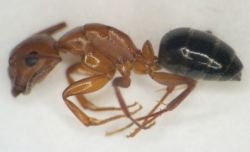Ants
 Description: Large - from 1/4 inch for a worker up to 3/4 inch (19.1mm) for a queen. They are black, or can be red and black.
Description: Large - from 1/4 inch for a worker up to 3/4 inch (19.1mm) for a queen. They are black, or can be red and black. Symptoms: Carpenter ants rarely cause structural damage to buildings. Although most carpenter ant damage is cosmetic, the ants are nevertheless considered serious pests by homeowners. Under natural conditions, carpenter ants nest in live and dead trees and in rotting logs and stumps. However, they will also construct their nests in houses, telephone poles, and other man-made wooden structures. Nests are begun in deteriorating wood which has been exposed to moisture. Often, the colony will extend its nest to adjacent, sound wood. Nests are commonly found in porch pillars and roofs, window sills, and wood in contact with soil.
Life Cycle: The colonies of carpenter ants are often long lived. Each colony is founded by a single fertilized queen. She establishes a nesting site in a cavity in wood. She then rears her first brood of workers, feeding them salivary secretions. She does not leave the nest nor feed herself throughout this period. The workers which are reared first assume the task of gathering food with which to feed the younger larvae. As the food supply becomes more constant, the colony population grows very rapidly. A colony does not reach maturity and become capable of producing young queens and males until it contains 2,000 or more workers. It may take a colony from three to six years or more to reach this stage. Each year thereafter, the colony will continue to produce winged queens and males, which leave their nest and conduct mating flights from May through July.
Red Imported Fire Ants:
 Description: The red imported fire ant (RIFA) is a small ant with workers varying from 1/8 to 1/ 4 inch long. It is usually dark reddish brown in color and has two nodes on the petiole and a two-segmented antennal club. They are similar in appearance to many of our common house and field ants and are especially difficult to distinguish from the Southern fire ant (Solenopsis xyloni), which is native to most areas of Oklahoma.
Description: The red imported fire ant (RIFA) is a small ant with workers varying from 1/8 to 1/ 4 inch long. It is usually dark reddish brown in color and has two nodes on the petiole and a two-segmented antennal club. They are similar in appearance to many of our common house and field ants and are especially difficult to distinguish from the Southern fire ant (Solenopsis xyloni), which is native to most areas of Oklahoma.
History: The red imported fire ant (RIFA) is native to the state of Mato Grosso in Brazil. It was introduced into the United States at Mobile, Alabama, about 1940. It spread rapidly through the southeastern U.S. during the 1940s and '50s. The first infestation found in Oklahoma was in the Waurika area of Jefferson County in July, 1985. The RIFA has continued to spread to the north and west. As of 2007, it has been found in over 40 counties. Many of these infestations are thought to be associated with movement of nursery stock and/or turf.
Life Cycle: New colonies are formed by one (or more) winged, mated females (queens) following a mating flight. The mated queens find suitable nesting sites, shed their wings, and begin digging underground chambers in which to lay eggs. The first eggs and larvae are cared for by the queen. They emerge as small workers after 3 to 4 weeks. Thereafter, the workers care for the queen and the brood, forage for food, and expand the nest. An undisturbed colony can increase in size rapidly and may contain 10,000 or more workers after one year. Winged reproductives will also be produced sometime in the second half of the first year. A mature colony (3 years old) may contain 100,000 to 500,000 workers and several hundred winged forms.
Symptoms: The most important problem with the RlFA is its sting. The workers can sting repeatedly and attack anything that disturbs their mounds or food sources. Symptoms of the sting include burning and itching, followed by the development of a pustule that may take a week or more to heal. Scratching these pustules can lead to secondary bacterial infections and can leave permanent scars. As usual with insect stings, certain persons are hypersensitive to fire ant venom and may suffer chest pains or nausea or lapse into a coma from one sting.
Birds and small animals can be harmed, or occasionally killed, by fire ant stings. They will also sting poultry and domestic animals. The presence of fire ants in crops or gardens may prevent hand picking of fruits and vegetables because of the threat of stings. The presence of mounds may damage harvesting equipment.
In cities, fire ants sometimes nest in electrical circuitry, and they have been known to short out air conditioners, get in telephone junction boxes, traffic and light control boxes, and in transformers. They sometimes nest under sidewalks or highways and as the colony dies out, the area of the nest will sink and cause a pot hole. Damage to plants occurs under some conditions. They will feed on germinating seeds, causing damage to corn and soybeans. They also feed on buds and developing fruits of crops such as beans, berries, okra, and citrus. They may girdle young trees in an attempt to find a source of water. Fire ants also feed on the honeydew produced by aphids. They often tend aphids on plants and the aphids damage the plants by their feeding activities.